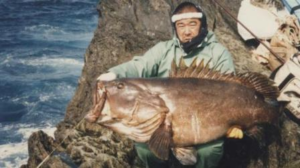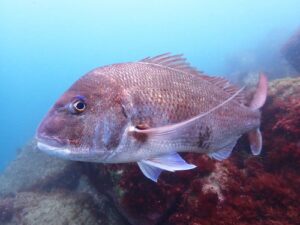History of Inchiku; the Ingenuity of Japanese Fisherman
Inchiku is easy to use and a very effective lure for offshore fishing. This Inchiku is often called an Inchiku Jig (the brief explanation about this lure on this New Zealand website.)
This Inchiku is from Japan, but its origin is not so clear for us. In this article, I would like to venture to search for the origin of this Inchiku, after looking briefly about its origin of Inchiku name.
The origin of “Inchiku” name
It is said that the name of the lure originates from words like these:
Inchiki; meaning “fraud” or “cheat”, and In-chiku; meaning “pulling the bamboo” or pulling the bamboo like sinker
I am rather for the former idea. If you finish reading below, you will know that Inchiku was a great invention of merging fishing techniques, and it must have been a surprisingly effective fishing tool. And you will be convinced that some people without Inchiku may have said that this invention was almost cheating.
In this article, I will explain how six factors that were combined to form Inchiku.
These factors are;
Japanese traditional lures, invention to fixture the line onto the sinker, lures for trolling, tilted lure posture, traveling fishermans and use of a thinner main line.
Factor 1; Japanese traditional lures
We have a traditional lure called Tsuno (literally means horn). They are actually made from antlers, bull horns, or bones. There are several fishing styles, which use Tsuno lures. One is commercial fishing for Bonito (or Skipjack Tuna). It uses a long whip rod, line connected directly from the rod to a Tsuno lure. Other styles are trolling and surf lure fishing, mostly for smaller Japanese Amberjack, Pacific mackerel, and so on.
Another type of traditional Japanese lure is Bake. This is a jig-head style lure (with feathers). This Bake is used in combination as a part of rigs, in the place of bait hook.
Factor 2; Invention of fixing the line to the lure
In the old times, there was no split ring or similar tool in proper size for the traditional lure. People needed to have some method to fix the line to the lures. One solution could be to mold the thin wire inside the lead. However, it was very hard to get thin wire. In the Edo period, the steel wire was so scarce that the hook was reused several times, with making the wire material softer intentionally to make it easy to bend back or to sharpen.
Facing such a situation, there were special ideas to fix the line from the side of the lead. To make a hole in the 90 degree angle of the hook shank direction, and to put the line through it.
Factor 3; Lures for trolling method
Trolling was a popular method in Chikuzen Province (curerntly Fukuoka prefecture), for Japanese Amberjack. They were using a leaded hand line, with a kind of a tin made lure, of cuboid type lure (image below). Underwater, being pulled by a certain speed, the lure must have moved in wavering motion. I suppose these people discovered or recognized the wavering motion of lure was effective.
You can view an example of the waver motion (with a metal jig, simulating straight retrieve)
Factor 4; Invention of tilted lure posture
Around Akashi or Kii areas, there was a record that some fishermans were using special lures. These lures swan in the tilted posture. It had the cylinder shaped head (of bamboo), with the angled hook. The shank of the hook is attached in the 45 degrees direction from the axle of the head. And the head received water resistance from the side, since the hook’s water resistance pulls the head at 45 degrees angle.
I suppose the head wobbled well and making the special movements in the feathers or bait attached on the hook.
Factor 5; Traveling fishermans
Between fishing ports in the Pacific side of Japan, there were a lot of fishermans traveling. According to some studies, there were many fishermans from the Kansai area (around Osaka and the Kii peninsula) who came to the Kanto area for fishing, from the middle of 16th century, or in the Edo period. There were certain periods when the catch of sardines were drastically reduced in the Kansai area. These forced many Kansai fishermans to search for other places to do their speciality work, fishing. As a consequence, fishing techniques were taken from Kansai to Kanto, and at the same time, some were taken back to Kansai, too. (For reference Japanese document)
Additionally, for fishing villages along the Japan sea (Sanin,and Hokuriku area,) winter lives were not easy because the weather there did not allow them to do any fishing. Wind was too strong, the waves were so high, and it snowed a lot. From the Taisho period until WW2, for fishermans in these areas, especially good skilled fishermans, the way to earn money in winter was to go to the Pacific side, such as the Boso peninsula, the Izu peninsula, the Kii peninsula, and the Awaji region. With this assumption, it is natural to think the above described factors were meeting together in their home ground.
(referenced document in Japanese. )
With these fishermans, firstly, the Pacific side’s fishing techniques were mixed, and secondly, Japan sea side’s fishermans brought back these techniques with them. It is likely that fishermans along the Japan sea had mixed the advantages of all the related techniques described above, and had made Inchiku, in the form we see now.
Factor 6; Usage of thin main line
Even more to get closer to current style, we need to get rid of the leaded main line. One had to wait until the invention of a thin and strong main line to let the rig sink enough without leaded lines.
The turning point was the invention of the nylon line. In Japan, the use of nylon main line was spread around the 1950's. (The nylon thread was invented in 1935, by Du Pont.) From then, the requirement of the leaded hand line became drastically reduced. At the same time, the rig weight (sinker weight near the hook) was increased, and the use of fishing rod with reel became more widespread.
And finally, all things combined, the modern Inchiku was born.
With all above described factors, you can now get the current action of Inchiku like in the video below.
Currently, the Inchiku’s origin can be seen in Marugo-namari (Maruko sinker.) It is still sold in specialized shops in Japan.
According to the manufacturer of commercial fishing tackles, this Marugo-namari has been in production since the middle of Showa era (1960’s), upon requests of commercial anglers along the Japan Sea coast.
Probably its mass-production started in the 1960's. And the area where there was that request for this shape were somewhere in Northern Kyoto prefecture (Maizuru and Tango), Fukui prefecture (Obama) and Ishikawa prefecture (Himi) and so on. There is still an fisherman who fishes for Yellowtail Amberjack, Japanese Amberjack, or Red spotted Grouper (Hong Kong Grouper), with leaded hand line.
Fishermans have been pursuing the better way to catch more fish or bigger fish, all the time. It is the same for all over the world. Now, anglers in many parts of the world are using Inchiku. And we can expect another mixture of traditional techniques may bear brand new angling technique.


One thought on “History of Inchiku; the Ingenuity of Japanese Fisherman”